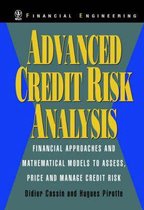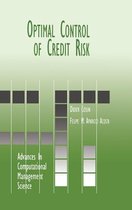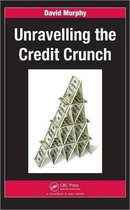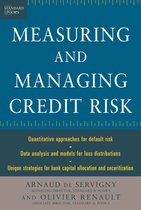Advanced Credit Risk Analysis & Manageme
Afbeeldingen
Sla de afbeeldingen overArtikel vergelijken
- Engels
- Hardcover
- 9781118604915
- 10 mei 2013
- 448 pagina's
Samenvatting
Credit is essential in the modern world and creates wealth, provided it is used wisely. The Global Credit Crisis during 2008/2009 has shown that sound understanding of underlying credit risk is crucial. If credit freezes, almost every activity in the economy is affected. The best way to utilize credit and get results is to understand credit risk.
Advanced Credit Risk Analysis and Management helps the reader to understand the various nuances of credit risk. It discusses various techniques to measure, analyze and manage credit risk for both lenders and borrowers. The book begins by defining what credit is and its advantages and disadvantages, the causes of credit risk, a brief historical overview of credit risk analysis and the strategic importance of credit risk in institutions that rely on claims or debtors. The book then details various techniques to study the entity level credit risks, including portfolio level credit risks.
Authored by a credit expert with two decades of experience in corporate finance and corporate credit risk, the book discusses the macroeconomic, industry and financial analysis for the study of credit risk. It covers credit risk grading and explains concepts including PD, EAD and LGD. It also highlights the distinction with equity risks and touches on credit risk pricing and the importance of credit risk in Basel Accords I, II and III. The two most common credit risks, project finance credit risk and working capital credit risk, are covered in detail with illustrations. The role of diversification and credit derivatives in credit portfolio management is considered. It also reflects on how a credit crisis develops in an economy by referring to the bubble formation. The book links with the 2008/2009 Global Credit Crisis and carries out an interesting discussion on how the credit crisis may have been avoided by following the fundamentals or principles of credit risk analysis and management.
The book is essential for both lenders and borrowers. Containing case studies adapted from real-life examples and exercises, this important text is practical, topical and challenging. It is useful for a wide spectrum of academics and practitioners in credit risk and anyone interested in commercial and corporate credit and related products.
Credit is essential in the modern world and creates wealth, provided it is used wisely. The Global Credit Crisis during 2008/2009 has shown that sound understanding of underlying credit risk is crucial. If credit freezes, almost every activity in the economy is affected. The best way to utilize credit and get results is to understand credit risk.
Advanced Credit Risk Analysis and Management helps the reader to understand the various nuances of credit risk. It discusses various techniques to measure, analyze and manage credit risk for both lenders and borrowers. The book begins by defining what credit is and its advantages and disadvantages, the causes of credit risk, a brief historical overview of credit risk analysis and the strategic importance of credit risk in institutions that rely on claims or debtors. The book then details various techniques to study the entity level credit risks, including portfolio level credit risks.
Authored by a credit expert with two decades of experience in corporate finance and corporate credit risk, the book discusses the macroeconomic, industry and financial analysis for the study of credit risk. It covers credit risk grading and explains concepts including PD, EAD and LGD. It also highlights the distinction with equity risks and touches on credit risk pricing and the importance of credit risk in Basel Accords I, II and III. The two most common credit risks, project finance credit risk and working capital credit risk, are covered in detail with illustrations. The role of diversification and credit derivatives in credit portfolio management is considered. It also reflects on how the credit crisis develops in an economy by referring to the bubble formation. The book links with the 2008/2009 credit crisis and carries out an interesting discussion on how the credit crisis may have been avoided by following the fundamentals or principles of credit risk analysis and management.
The book is essential for both lenders and borrowers. Containing case studies adapted from real life examples and exercises, this important text is practical, topical and challenging. It is useful for a wide spectrum of academics and practitioners in credit risk and anyone interested in commercial and corporate credit and related products.
Productspecificaties
Inhoud
- Taal
- en
- Bindwijze
- Hardcover
- Oorspronkelijke releasedatum
- 10 mei 2013
- Aantal pagina's
- 448
- Illustraties
- Nee
Betrokkenen
- Hoofdauteur
- Ciby Joseph
- Tweede Auteur
- C Joseph
- Co Auteur
- C Joseph
- Hoofduitgeverij
- WILQ
Overige kenmerken
- Extra groot lettertype
- Nee
- Product breedte
- 170 mm
- Product hoogte
- 31 mm
- Product lengte
- 252 mm
- Studieboek
- Nee
- Verpakking breedte
- 179 mm
- Verpakking hoogte
- 31 mm
- Verpakking lengte
- 252 mm
- Verpakkingsgewicht
- 1164 g
EAN
- EAN
- 9781118604915
Je vindt dit artikel in
- Boek, ebook of luisterboek?
- Boek
- Taal
- Engels
- Beschikbaarheid
- Leverbaar
- Studieboek of algemeen
- Algemene boeken
Kies gewenste uitvoering
Prijsinformatie en bestellen
De prijs van dit product is 74 euro en 99 cent.- Prijs inclusief verzendkosten, verstuurd door bol
- Ophalen bij een bol afhaalpunt mogelijk
- 30 dagen bedenktijd en gratis retourneren
- Dag en nacht klantenservice
Rapporteer dit artikel
Je wilt melding doen van illegale inhoud over dit artikel:
- Ik wil melding doen als klant
- Ik wil melding doen als autoriteit of trusted flagger
- Ik wil melding doen als partner
- Ik wil melding doen als merkhouder
Geen klant, autoriteit, trusted flagger, merkhouder of partner? Gebruik dan onderstaande link om melding te doen.








